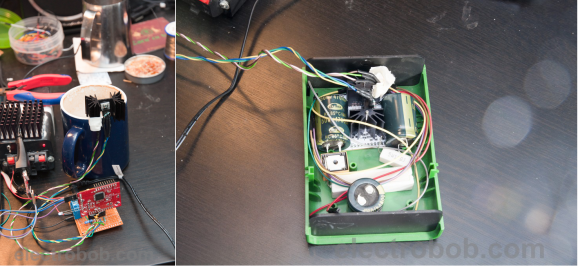 [Bogdan] knows that it’s hard to model the cooling needs of any given project. It’s important to know how much heat a system can dissipate given the housing material, airflow opportunity, and the proximity of neighboring components. Inspired by an aluminium-walled enclosure that allows for mounted transistors, he devised and built a heatsink tester.
[Bogdan] knows that it’s hard to model the cooling needs of any given project. It’s important to know how much heat a system can dissipate given the housing material, airflow opportunity, and the proximity of neighboring components. Inspired by an aluminium-walled enclosure that allows for mounted transistors, he devised and built a heatsink tester.
He’s using an ATXMEGA32A4U, a temperature sensor, and a IRF540 MOSFET. A specific power is dissipated across the transistor, and the temperature sensor measures the heatsink as close as possible to the transistor. Through the serial connection, he gets back the supply voltage, current, calculated power, DAC set, temperature, and calculated thermal resistance in the terminal.
[Bogdan]’s tester assumes that it is reading the ambient temperature, so the circuit needs to warm up first. He found that an hour is generally long enough to reach this point. He also found that the system exhibits high thermal inertia, so it regulates the DAC output based on the dissipated power.















One of my (favorite) Electronics instructors said, “If you are asked what is a ‘heat sink’ during a job interview, don’t say “it’s where you dump the heat when you’re done with it”,” B^) Although in a metaphorical sense, that’s just what you do…
I also like seeing “heat sync” as it kind of does that too, or at least tries to?
Resistance is futile if less than one Ohm
“Resistance is futile if less than one Ohm”
tell that to a guy who has a faulty grounding strap on his car battery… B^)
(in that case, starting may be futile)
With planned obsolescence grown more and more, I bet there’s someone somewhere using this kind of devices for evil
Beta test
With planned obsolescence showing its ugly face in more and more electronics, I bet there’s someone somewhere using this kind of devices for evil
v1.0
Could you hack this thing into a fancy toilet door status indicator?
what
He’s referring to an ongoing HackaDay joke…
Of course you can! just measure the resistance of the toilet seat. A larger value will indicate it is free while a lower value will indicate someone is sitting on it. Then its just a matter of making an indicator to show the status.
No, then it is just a matter of pulsing the Toilet Seat with High Voltage until it is no longer occupied! B^)
Problematic if they’re no longer sitting, but struggling to get their pants up!